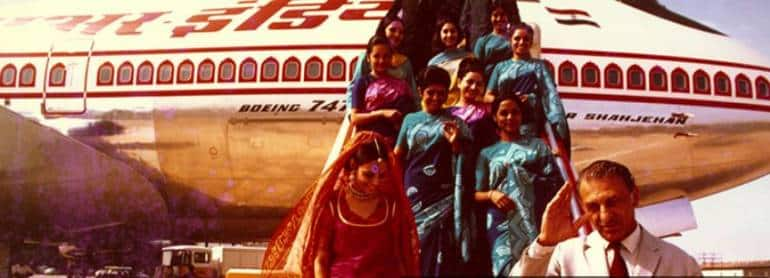A woman uses her phone to take photographs of Natarajan Chandrasekaran, newly appointed Chairman of Tata Sons, as he arrives at the company's head office in Mumbai, India February 21, 2017. REUTERS/Shailesh Andrade - RTSZKH0
In February, N Chandrasekaran will complete four years as the Chairman of Tata Sons, the holding company of the salt-to-steel conglomerate. From the many unfinished businesses - and he has some - that he has his eyes on, Group's aviation interest will be right at the top of his priority.
Going by reports and the industry buzz with many executives affirming the same with Moneycontrol, it looks like a surety that Tata Sons will be submitting its interest in Air India, the state airline that the government is eager to lose control of.
"In many ways, Chandrasekaran needs Air India to salvage the Group's aviation business. There was a chance to do with Jet Airways, but that didn't happen," says a senior executive from the industry with experience in Indian and multinational airlines.
When he took over in 2017, the Tata Sons Chairman had said that he wanted each company in the group to be 'top performers' in the respective sector. But in aviation, the group's two interests - Vistara with Singapore Airlines and AirAsia India with AirAsia Berhad- continue to lag near the bottom of the industry.
From a combined market share of 7.2 percent at the end of 2017, Vistara and AirAsia India have increased their pie size to 13.2 percent by October 2020. While one could argue that the two have managed to nearly double their share, industry leader IndiGo has performed better when one looks at the percentage point improvement - from 39.6 percent in 2017, to a market share of 51 percent in October 2020.
"With Air India (which has 11 percent of the domestic market), that market share zooms to nearly a quarter of the whole pie. That brings in scale," says the senior executive quoted above. The scale will bring in the ability to better manage fixed costs, he added.
The more juicy opportunity will be the possible dominance on international routes. "There is no Jet Airways, at least not yet. IndiGo doesn't seem to be keen on the long haul and others are just experimenting. With Air India, and its slots, flying rights and offices, the Tatas will get to dominate international travel, from and to India," said an executive from an international airline.
Air India, along with its low-cost unit Air India Express that flies majorly to the Middle-East destinations, has a fleet of nearly 90 aircraft. The airline flies to over 40 international destinations. Air India Express will also be sold along with its parent.
But what about Vistara, a full service airline, and AirAsia India, a low-cost carrier?
"It will make sense to merge Vistara with Air India, and AirAsia India with Air India Express," the above executive added.
Merging Vistara with Air India will allow it to retain its full-service avatar. "Along with Singapore Airlines, there is an opportunity to dominate international skies," said the executive. And along with AirAsia India, Air India Express can look to make a similar presence in South-East Asia, as it has in the Middle-East.
The Tatas are at present in talks with AirAsia Berhad, which seems to be keen to exit their India joint venture as it looks to limit losses in its global operations. The Malaysian company has already announced closure of its business in Japan.
AirAsia India's revenue dropped 69 percent in the September quarter. While its losses for the second quarter weren't disclosed, in the first, it went deeper in the red. Its losses zoomed to Rs 332 crore, from Rs 15 crore, a year earlier.
On the other hand, Vistara reported losses of Rs 1,270 crore in FY20, and this is expected to widen further in the present year that has been severely dented by COVID-19.
But can merging two loss-making entities into a larger company, which has been in red for a while and is surviving on government largess, work?
 JRD Tata, the late Tata Sons Chairman, was at the helm of Air India till 1977
JRD Tata, the late Tata Sons Chairman, was at the helm of Air India till 1977
Turnaround expertise?
Air India lost an average of Rs 28 crore a day, in the first three months of the financial year. Its losses widened to Rs 2,570 crore in the June quarter, from Rs 785 crore a year earlier.
Can the Tatas stop the rot?
"Turning around Air India is not going to be easy, and is likely to be a huge cash drain. The Tatas do not have the expertise to do this by themselves, neither do SIA or Air Asia have the expertise," said a senior official of a private airline.
Vistara, which has a fleet of 40 aircraft airlines, has "bloated costs," the official said. "This is despite starting fresh with a clean sheet of paper. It is unlikely to be able to swallow, digest, and run a much larger and more complex entity," he said.
Instead, adds an executive from an aviation consultancy, the Tatas could partner with a US airline. "US airlines have significant bankruptcy and restructuring experience, including experience in dealing with legacy contracts and unions. They know first hand what it takes to turn around and restructure struggling legacy airlines," he said.
One of the options could be Delta Air Lines, which in 2007 had gone through a 19-month, $3 billion restructuring. The airline had even shown interest in Air India. Talking to PTI in December 2019, a senior official said, "We will look at any opportunity." The airline had also shown interest in Jet Airways.
The aviation consultant suggests something more radical: "It would be easier and much cheaper to set up a new airline with the Air India brand name, than to fix the current Air India."
That could be an option if the current divestment ends up with no buyer. "If the current entity is liquidated and sold for parts, someone could buy the brand and the Air Operator Permit," he adds.
The government will be hoping to avoid that eventuality. While the deadline to submit bids is December 14, the government will short list them by January 5.












_2020091018165303jzv.jpg)
















 JRD Tata, the late Tata Sons Chairman, was at the helm of Air India till 1977
JRD Tata, the late Tata Sons Chairman, was at the helm of Air India till 1977









